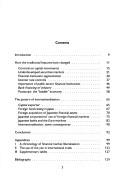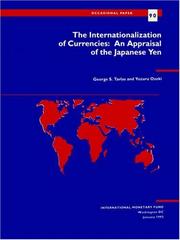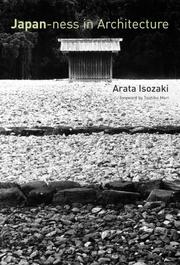| Listing 1 - 10 of 13 | << page >> |
Sort by
|

ISBN: 9291310328 9789291310326 Year: 1992 Volume: 34 Publisher: Basle Bank for International Settlements
Abstract | Keywords | Export | Availability | Bookmark
 Loading...
Loading...Choose an application
- Reference Manager
- EndNote
- RefWorks (Direct export to RefWorks)
International finance --- Japan --- Finance --- Capital market --- 339.72 <520> --- -marches financiers --- japon --- marches financiers --- JP / Japan - Japon --- 333.600 --- Capital markets --- Market, Capital --- Financial institutions --- Loans --- Money market --- Securities --- Crowding out (Economics) --- Efficient market theory --- Internationaal betalingsverkeer. Valutahandel. Wisselmarkten. Deviezenhandel. Internationale kapitaalmarkt. Flow and funds analysis. Betalingsbalans. Internationale geldmarkt.--Japan --- financiele markten --- japan --- Financiële markten. Kapitaalmarkten (algemeenheden). --- Working papers --- 339.72 <520> Internationaal betalingsverkeer. Valutahandel. Wisselmarkten. Deviezenhandel. Internationale kapitaalmarkt. Flow and funds analysis. Betalingsbalans. Internationale geldmarkt.--Japan --- Financiële markten. Kapitaalmarkten (algemeenheden) --- Finance - Japan. --- Capital market - Japan.
Book
ISBN: 9783836507356 3836507358 Year: 2010 Publisher: Köln...Tokyo: Taschen,
Abstract | Keywords | Export | Availability | Bookmark
 Loading...
Loading...Choose an application
- Reference Manager
- EndNote
- RefWorks (Direct export to RefWorks)
Shigeru Ban (né à Tokyo en 1957) a étudié à la SCI-Arc de Californie et obtenu son diplôme à la Cooper Union School of Architecture de New York. Installé à Tokyo et à Paris, Ban a profondément remis en cause les normes traditionnelles de l'architecture, dessinant une maison sans murs ou un espace d'exposition fait de tubes de papier et de containers de transport. Cette monographie, élaborée en collaboration avec l'architecte, retrace la carrière de Shigeru Ban et présente chacune de ses réalisations, faisant clairement apparaître pourquoi il est l'un des architectes les plus innovants et les plus importants au monde. Contrairement à bon nombre de ses pairs, Ban peut créer des demeures exceptionnelles tout en trouvant le temps de dessiner des logements provisoires pour des zones sinistrées, comme celles de Kobe ou de la Nouvelle-Orléans. Utilisant souvent le papier ou des tubes de carton comme éléments de structure, ses créations ont donné un nouveau sens à l'expression "architecte de papier". À propos de l'auteur: Philip Jodidio (né en 1954) a étudié l'histoire de l'art et l'économie à l'Université d'Harvard, et a été rédacteur en chef du magazine français Connaissance des Arts pendant plus de vingt ans. Il a publié de nombreux articles et livres sur l'architecture contemporaine, dont, chez TASCHEN, la série Architecture Now! ainsi que des monographies sur Tadao Ando, Norman Foster, Richard Meier, Jean Nouvel et Zaha Hadid. Il est un des auteurs internationaux les plus lus dans le domaine de l'architecture. http://www.taschen.com/pages/fr/catalogue/architecture/all/04945/facts.shigeru_ban_complete_works_1985_2010.htm (19/08/10)
Architects --- Architecture, Modern --- Architectes --- Architecture --- Ban, Shigeru, --- Monographie --- Ban, Shigeru --- 72.07 --- 72.038 --- 72.039 --- 72(520) --- Architectuur ; 1985-2010 ; Shigeru Ban --- Ban, Shigeru °1957 (°Tokio, Japan) --- Bouwmaterialen ; karton ; papier ; hout ; bamboe --- Tijdelijke architectuur ; voor daklozen --- Woninbouw ; voor vluchtelingenkampen --- Sociale woningbouw ; volkshuisvesting --- Ruimtelijke constructies ; overspanningen ; kapconstructies --- Tentstructuren --- Architecten. Stedenbouwkundigen A - Z --- Architectuurgeschiedenis ; 1950 - 2000 --- Architectuurgeschiedenis ; 2000 - 2050 --- Architectuur ; Japan
Book
ISBN: 9784863585836 4863585837 Year: 2018 Publisher: Tokyo Shimoda Yasunari, Echelle-1, Inc.,
Abstract | Keywords | Export | Availability | Bookmark
 Loading...
Loading...Choose an application
- Reference Manager
- EndNote
- RefWorks (Direct export to RefWorks)
As in the eponymous exhibition at Mori Art Museum, this volume examines the characteristics of ancient and classical Japanese architecture in a very ambitious attempt to elucidate the major currents of the nation’s architecture from the perspectives of how its genealogies have spread internationally, the pioneering figures in the process, and the mechanisms behind the continued expansion of these genealogies today. It documents 100 projects across nine thematic sections, including materials, models, documents, and interactive installations. Nine stories which are ultimately hypothetical ones, in hopes that they will lead to new discussions and visions for the future of Japan.
Architecture --- 72(520) --- Architectuur ; Japan ; traditionele en hedendaagse --- Japanse architectuur ; in en buiten buiten Japan --- 72.036 --- 72.037 --- Japan --- Architecture, Western (Western countries) --- Building design --- Buildings --- Construction --- Western architecture (Western countries) --- Art --- Building --- History --- Architectuur ; Japan --- 20ste eeuw (architectuur) --- 21ste eeuw (architectuur) --- Design and construction --- architecture [discipline] --- Architecture, Primitive

ISBN: 1557751978 Year: 1992 Publisher: Washington, D.C. IMF
Abstract | Keywords | Export | Availability | Bookmark
 Loading...
Loading...Choose an application
- Reference Manager
- EndNote
- RefWorks (Direct export to RefWorks)
International finance --- Monetary policy --- Yen, Japanese --- 330.05 --- 332.4560952 --- 333.111.42 --- 333.432.0 --- 333.432.8 --- 333.453 --- 333.46 --- AA* / International - Internationaal --- JP / Japan - Japon --- 336.74 <520> --- 339.72 <520> --- International monetary system --- International money --- Finance --- International economic relations --- Japanese yen --- Money --- 336.74 <520> Geld. Geldwezen. Monetaire sector.--Japan --- Geld. Geldwezen. Monetaire sector.--Japan --- 339.72 <520> Internationaal betalingsverkeer. Valutahandel. Wisselmarkten. Deviezenhandel. Internationale kapitaalmarkt. Flow and funds analysis. Betalingsbalans. Internationale geldmarkt.--Japan --- Internationaal betalingsverkeer. Valutahandel. Wisselmarkten. Deviezenhandel. Internationale kapitaalmarkt. Flow and funds analysis. Betalingsbalans. Internationale geldmarkt.--Japan --- goudreserves en deviezenreserves --- Monetaire akkoorden en conventies: algemeenheden --- Internationale monetaire organisatie. Internationaal Muntfonds. Algemene leningovereenkomsten --- Internationale munt. Rekeneenheden --- Monetaire toestand en evolutie --- Working papers --- Money. Monetary policy --- Japan
Book
ISBN: 9068680935 Year: 1995 Publisher: Bussum Thoth
Abstract | Keywords | Export | Availability | Bookmark
 Loading...
Loading...Choose an application
- Reference Manager
- EndNote
- RefWorks (Direct export to RefWorks)
urban development --- landscapes [environments] --- Environmental planning --- Architecture --- architecture [discipline] --- Japan --- 72.036 <52> --- Landscape architecture --- -Architecture --- -Architectuur ; stedenbouw ; landschap ; Japan --- 72(520) --- Architecture, Western (Western countries) --- Building design --- Buildings --- Construction --- Western architecture (Western countries) --- Art --- Building --- Horticultural service industry --- Landscape gardening --- Landscaping industry --- Moderne bouwkunst. Architectuur van de 20e eeuw--Japan en omliggende eilanden --- Architectuur ; Japan --- Design and construction --- History --- 72.036 <52> Moderne bouwkunst. Architectuur van de 20e eeuw--Japan en omliggende eilanden --- Architectuur ; stedenbouw ; landschap ; Japan --- Architecture, Modern
Book
ISBN: 3775701818 Year: 1983 Publisher: Düsseldorf : Akademie der Architektenkammer Nordrhein-Westfalen,
Abstract | Keywords | Export | Availability | Bookmark
 Loading...
Loading...Choose an application
- Reference Manager
- EndNote
- RefWorks (Direct export to RefWorks)
Architecture --- History --- Histoire --- 72.03 --- 72.032.12 --- Japan --- architectuur --- architectuurgeschiedenis --- Architectuurgeschiedenis --- Architectuur (geschiedenis) --- Japanse architectuur --- 72.038(520) --- Architectuurgeschiedenis ; 1950 - 2000 ; Japan --- Exhibitions --- 72(520) --- Architectuur ; Japan ; heden en verleden --- Taut, Bruno ; over Japanse architectuur en woningbouw --- Stedenbouw ; Tokyo --- Metabolisme --- Architecture, Modern --- Architecture, Western (Western countries) --- Building design --- Buildings --- Construction --- Western architecture (Western countries) --- Art --- Building --- Architectuur ; Japan --- Architectuurgeschiedenis ; Japanse architectuur --- Design and construction --- Architecture, Primitive --- Japon --- 20e siècle

ISBN: 9780262090384 0262090384 9780262516051 0262516055 Year: 2011 Publisher: Cambridge, Mass London MIT
Abstract | Keywords | Export | Availability | Bookmark
 Loading...
Loading...Choose an application
- Reference Manager
- EndNote
- RefWorks (Direct export to RefWorks)
"One of Japan's leading architects examines notions of Japan-ness as exemplified by key events in Japanese architectural history from the seventh to the twentieth century; essays on buildings and their cultural context."--Publisher's description.
Architecture --- 72 --- 72.03 --- Japan --- 72.032.12 --- Isozaki, Arata --- Architecture, Japanese --- Philosophy. --- Architectuur --- Architectuur (geschiedenis) --- Architectuurgeschiedenis --- Japanse architectuur --- Architecture. --- Architektur --- Philosophie --- Architektur. --- Philosophie. --- Arkitektur. --- Chōsen Kōgei Kenkyūkai --- Japan. --- Philosophy --- Isozaki, Arata. --- 72.07 --- 72.01 --- 72(520) --- Arata Isozaki °1931 (°Oita City, Japan) --- Architectuur ; 2de h. 20ste eeuw ; A. Isozaki --- Metabolisme --- Architecten. Stedenbouwkundigen A - Z --- Architectuur ; theorie, filosofie, esthetica --- Architectuur ; Japan --- J6500 --- Japan: Art and antiquities -- architecture
Book
ISBN: 9783868595086 3868595082 Year: 2018 Publisher: Berlin Jovis
Abstract | Keywords | Export | Availability | Bookmark
 Loading...
Loading...Choose an application
- Reference Manager
- EndNote
- RefWorks (Direct export to RefWorks)
What lies at the root of Japanese creativity and its architectural artifacts? In his book, the Japanese architect Yuichiro Edagawa explores this question in detail. By analyzing a wide variety of unique exemplary buildings from the sixth century to the present, he determines twelve distinctive characteristics of Japanese architectural creativity and composition, including: intimacy with nature, importance of materials, bipolarity and diversity, asymmetry, devotion to small space, and organic form. The key understanding, which pervades all these characteristics, is that parts precede the whole. The Japanese process of creation begins with designing parts and details and ends with combining them to one edifice, instead of starting with a whole structure and working out the components afterwards. Edagawa provides a personal and comprehensive understanding of Japanese creativity and the architectural process. The book gives us an inspiring insight into Japanese culture and identity, which in its essence is deeply traditional and modern at the same time.
architecture [discipline] --- Architecture --- Japanese [culture or style] --- Japan --- Architecture, Japanese --- Creation (Literary, artistic, etc.) --- 72(520) --- Creative ability in art --- Creative ability in literature --- Art --- Imagination --- Inspiration --- Literature --- Creative ability --- Originality --- Japanese architecture --- Architectuur ; Japan --- Architecture, Japanese. --- J6500 --- Japan: Art and antiquities -- architecture --- Architectuurbeschouwing ; Japanse architectuur en creativiteit --- Création (esthétique) --- Jardins à la japonaise --- Architecture, Japon --- Creation --- Création (esthétique) --- Jardins à la japonaise
Book
ISBN: 9783721209976 Year: 2020 Publisher: Salenstein Niggli
Abstract | Keywords | Export | Availability | Bookmark
 Loading...
Loading...Choose an application
- Reference Manager
- EndNote
- RefWorks (Direct export to RefWorks)
Japanese culture and architecture have always fascinated the Western world. One particular, architecturally complex building type at the intersection of multiple currents of Japanese philosophy, art and esthetics is the Japanese teahouse. It is a very private place of meditation, a place where only those may enter who have been invited, in which the host communicates with his or her guests through the medium of tea in the context of the strictly regimented ceremony. This volume expands the reader’s knowledge of the built space that makes this tea ceremony possible. The author explores the philosophical background as well as the stylistic and spatial principles. He takes the reader on a cultural-historical and architectural journey through time, from the beginnings in the 15th century, when the art of the tea ceremony as well as the space in which it took place were recorded for the first time, to the present day, when the design and construction of a teahouse is still perceived in Japan as a great challenge for designers and architects.
Architecture --- Chashitsu --- Cérémonie du thé --- Japan --- 721 --- 72.031.4 --- 72.03 --- 728 --- J6876 --- J6574 --- J6568 --- Gebouwen (architectuur) --- Gebouwen (Typologie) --- Traditionele architectuur --- Vernaculaire architectuur --- Architectuur (geschiedenis) --- Architectuurgeschiedenis --- Burgerlijke architectuur --- Huizen --- Japan: Artistic games and pastime -- tea ceremony (sadō, chadō, cha no yu) --- Japan: Art and antiquities -- architecture -- recreative buildings --- Japan: Art and antiquities -- architecture -- pavilions --- 72(520) --- 72.032.12 --- 72.031.2(520) --- Theehuizen --- Architectuur ; Japan --- Architectuurgeschiedenis ; Japanse architectuur --- Architectuurgeschiedenis ; primitieve en vernaculaire architectuur ; Japan --- Cérémonie du thé
Book
ISBN: 9780714846651 0714846651 Year: 2008 Publisher: London Phaidon
Abstract | Keywords | Export | Availability | Bookmark
 Loading...
Loading...Choose an application
- Reference Manager
- EndNote
- RefWorks (Direct export to RefWorks)
Hitoshi Abe is widel considered to be one of the most interesting among the new generation of emerging Japanese architects. After graduating from the Southern California Institute of Architecture, he worked in the Los Angeles office of Coop Himmelb(l)au before obtaining his PhD from Tohoku University and setting up his own practice, Atelier Hitoshi Abe, in Sendai, Japan. Since the practice was established in 1992, Abe has won a wide variety of commissions across the country. He has also taught at several architecture schools, including the Tohoku Institute of Technology, the University of California Berkeley, and the University of California Los Angeles, where he is currently Chair of the Department of Architecture and Urban Design. This is the first monograph on Hitoshi Abe to be published in English. It features 26 projects realised in the last 15 years, covering a broad range of building types. Projects include Miyagi Stadium, Reihoku Community Hall, Kanno Museum, Yomiuri Media Miyagi Guest House and the F-town Building. Written by Naomi Pollock, an authority on Japanese design and architecture, this book is an essential reference work on this promising young architect.
Architecture contemporaine --- Architecture --- Architecte --- History --- Abe, Hitoshi --- Abe, Hitoshi, --- Japon --- 72.039 --- 72.07 --- 72(520) --- Architectuur ; 1994-2008 ; Hitoshi Abe --- Abe, Hitoshi °1962 (°Sendai, Miyagi, Japan) --- Architectuur ; vnl. Japan ; 21ste eeuw --- Hedendaagse architectuur. Bouwkunst sinds 1960 --- Architecten. Stedenbouwkundigen A - Z --- Architectuurgeschiedenis ; 2000 - 2050 --- Architectuur ; Japan --- 72.039 Hedendaagse architectuur. Bouwkunst sinds 1960 --- Architecture, Western (Western countries) --- Building design --- Buildings --- Construction --- Western architecture (Western countries) --- Art --- Building --- Architecture, Modern --- Design and construction --- 阿部仁史, --- Architecture, Primitive --- Architecture - Japan - History - 20th century --- Architecture - Japan - 21st century --- Abe, Hitoshi, - 1962 --- -Japon
| Listing 1 - 10 of 13 | << page >> |
Sort by
|

 Search
Search Feedback
Feedback About UniCat
About UniCat  Help
Help News
News